Finnegan Constructions Sustainability Assessment Report - MBA402
VerifiedAdded on 2022/08/14
|10
|2405
|18
Report
AI Summary
This report provides a comprehensive sustainability assessment of Finnegan Constructions, a fictional construction company, based on the GRI Sustainability Reporting Standards 2016. The analysis covers economic, environmental, and social sustainability aspects. Economically, the report examines the company's climate change risks, incidents of corruption, and anti-competitive behavior. Environmentally, it assesses energy consumption, impacts on biodiversity, and non-compliance with environmental regulations. Socially, the report evaluates employment management, employee discrimination cases, and community development initiatives. The assessment highlights the company's strengths and weaknesses, offering insights into its sustainability performance and areas for improvement. The report utilizes the provided case study and YouTube clips to fulfill the requirements of the MBA402 course assessment.
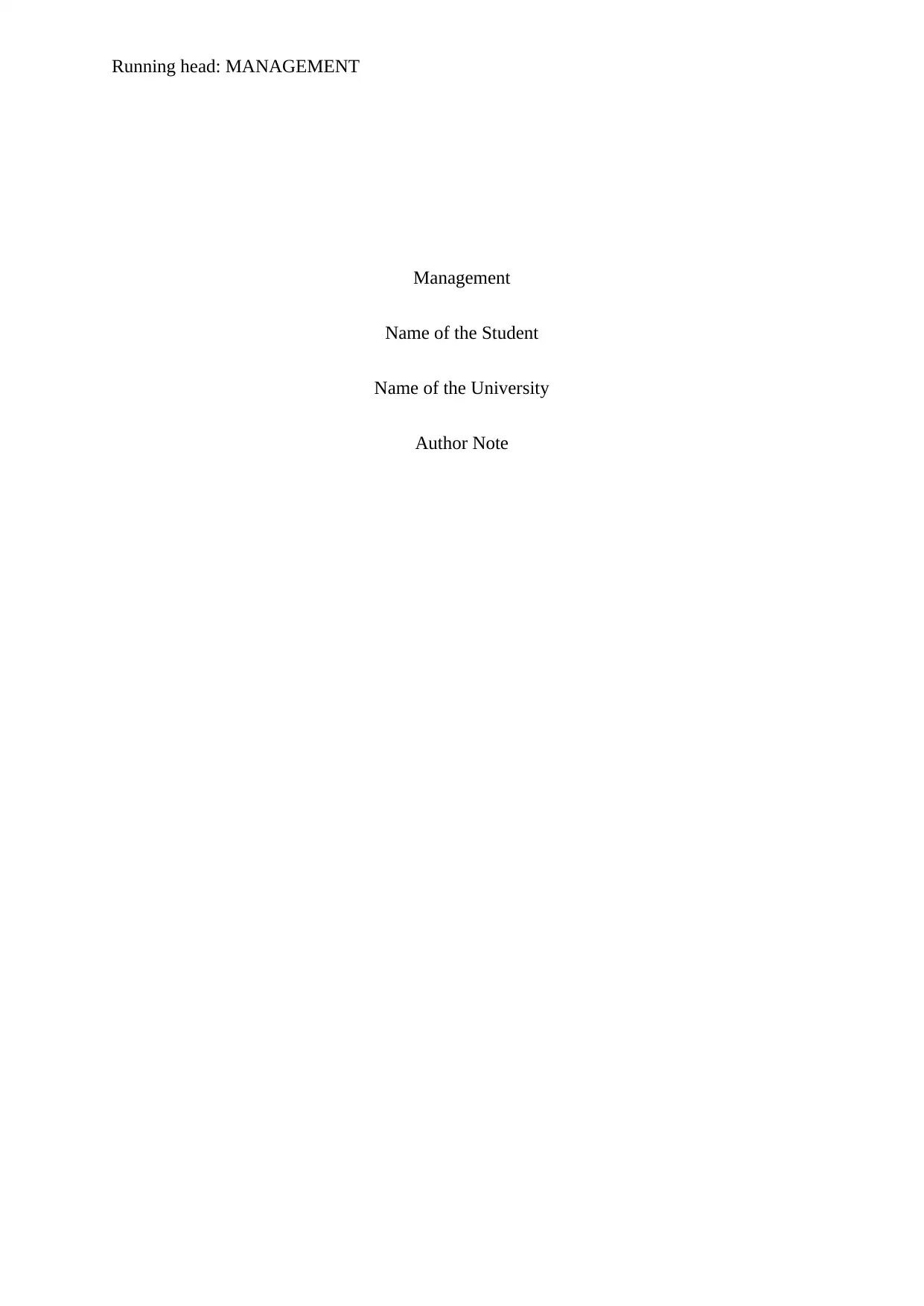
Running head: MANAGEMENT
Management
Name of the Student
Name of the University
Author Note
Management
Name of the Student
Name of the University
Author Note
Paraphrase This Document
Need a fresh take? Get an instant paraphrase of this document with our AI Paraphraser
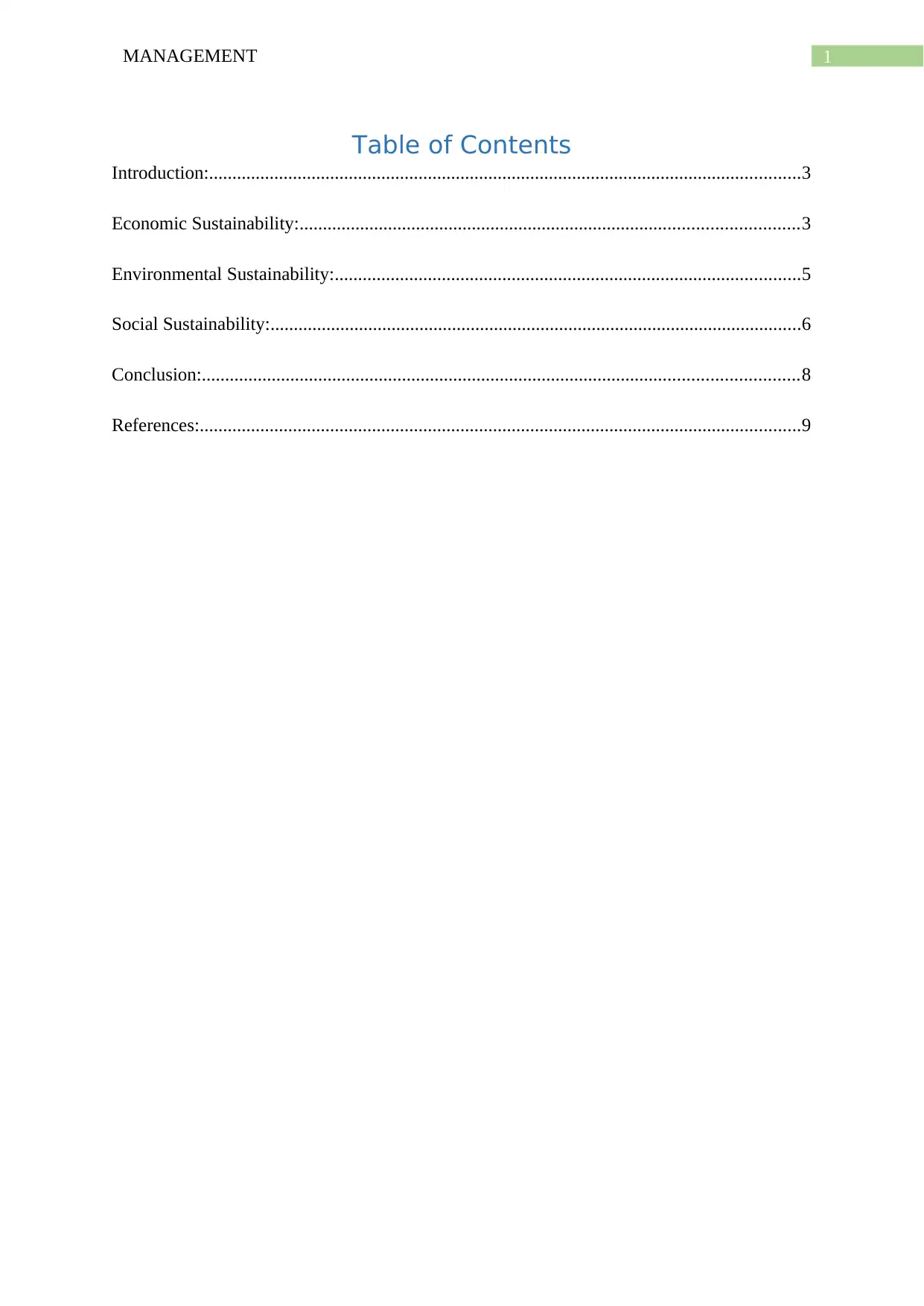
1MANAGEMENT
Table of Contents
Introduction:...............................................................................................................................3
Economic Sustainability:...........................................................................................................3
Environmental Sustainability:....................................................................................................5
Social Sustainability:..................................................................................................................6
Conclusion:................................................................................................................................8
References:.................................................................................................................................9
Table of Contents
Introduction:...............................................................................................................................3
Economic Sustainability:...........................................................................................................3
Environmental Sustainability:....................................................................................................5
Social Sustainability:..................................................................................................................6
Conclusion:................................................................................................................................8
References:.................................................................................................................................9
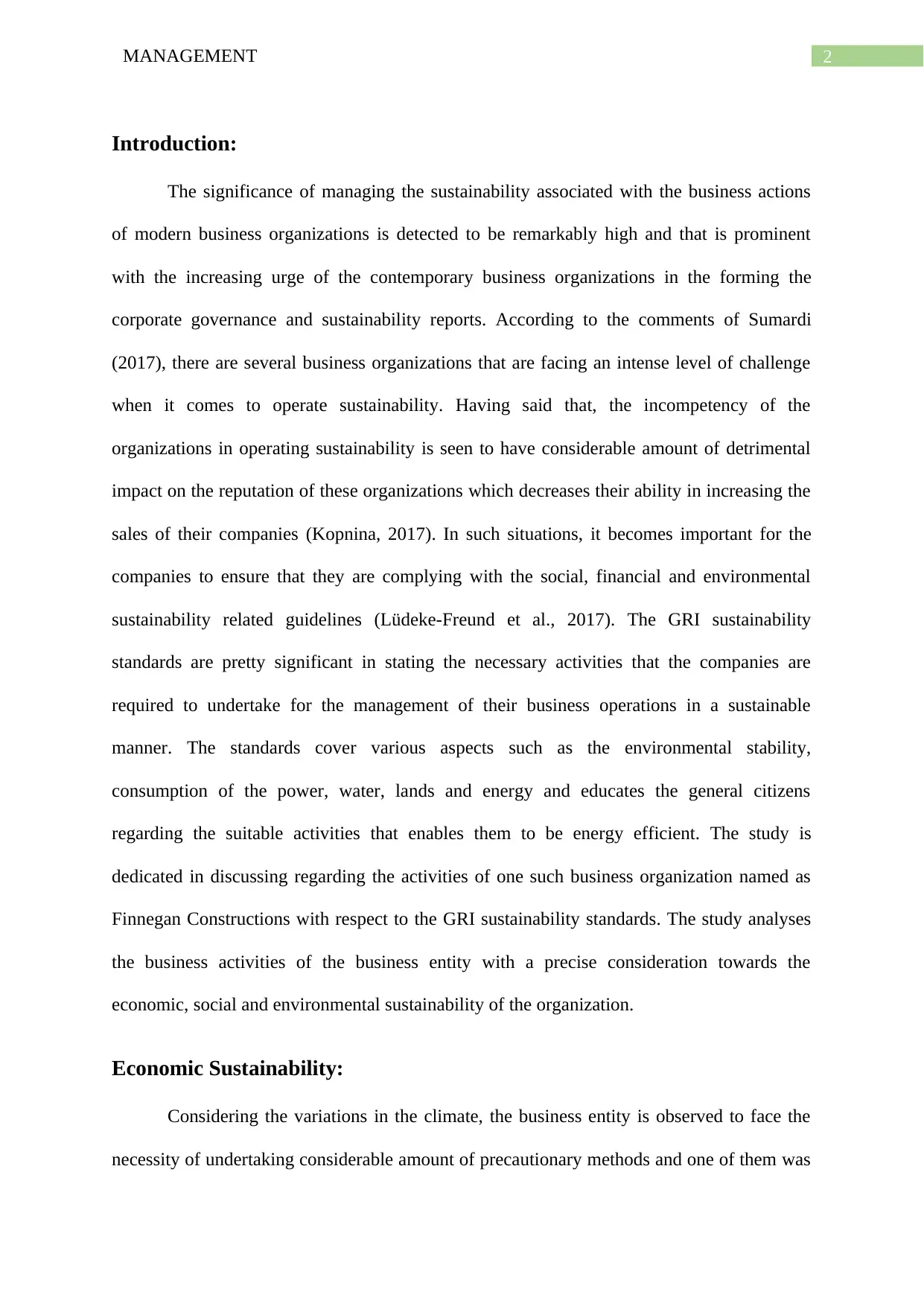
2MANAGEMENT
Introduction:
The significance of managing the sustainability associated with the business actions
of modern business organizations is detected to be remarkably high and that is prominent
with the increasing urge of the contemporary business organizations in the forming the
corporate governance and sustainability reports. According to the comments of Sumardi
(2017), there are several business organizations that are facing an intense level of challenge
when it comes to operate sustainability. Having said that, the incompetency of the
organizations in operating sustainability is seen to have considerable amount of detrimental
impact on the reputation of these organizations which decreases their ability in increasing the
sales of their companies (Kopnina, 2017). In such situations, it becomes important for the
companies to ensure that they are complying with the social, financial and environmental
sustainability related guidelines (Lüdeke-Freund et al., 2017). The GRI sustainability
standards are pretty significant in stating the necessary activities that the companies are
required to undertake for the management of their business operations in a sustainable
manner. The standards cover various aspects such as the environmental stability,
consumption of the power, water, lands and energy and educates the general citizens
regarding the suitable activities that enables them to be energy efficient. The study is
dedicated in discussing regarding the activities of one such business organization named as
Finnegan Constructions with respect to the GRI sustainability standards. The study analyses
the business activities of the business entity with a precise consideration towards the
economic, social and environmental sustainability of the organization.
Economic Sustainability:
Considering the variations in the climate, the business entity is observed to face the
necessity of undertaking considerable amount of precautionary methods and one of them was
Introduction:
The significance of managing the sustainability associated with the business actions
of modern business organizations is detected to be remarkably high and that is prominent
with the increasing urge of the contemporary business organizations in the forming the
corporate governance and sustainability reports. According to the comments of Sumardi
(2017), there are several business organizations that are facing an intense level of challenge
when it comes to operate sustainability. Having said that, the incompetency of the
organizations in operating sustainability is seen to have considerable amount of detrimental
impact on the reputation of these organizations which decreases their ability in increasing the
sales of their companies (Kopnina, 2017). In such situations, it becomes important for the
companies to ensure that they are complying with the social, financial and environmental
sustainability related guidelines (Lüdeke-Freund et al., 2017). The GRI sustainability
standards are pretty significant in stating the necessary activities that the companies are
required to undertake for the management of their business operations in a sustainable
manner. The standards cover various aspects such as the environmental stability,
consumption of the power, water, lands and energy and educates the general citizens
regarding the suitable activities that enables them to be energy efficient. The study is
dedicated in discussing regarding the activities of one such business organization named as
Finnegan Constructions with respect to the GRI sustainability standards. The study analyses
the business activities of the business entity with a precise consideration towards the
economic, social and environmental sustainability of the organization.
Economic Sustainability:
Considering the variations in the climate, the business entity is observed to face the
necessity of undertaking considerable amount of precautionary methods and one of them was
⊘ This is a preview!⊘
Do you want full access?
Subscribe today to unlock all pages.

Trusted by 1+ million students worldwide
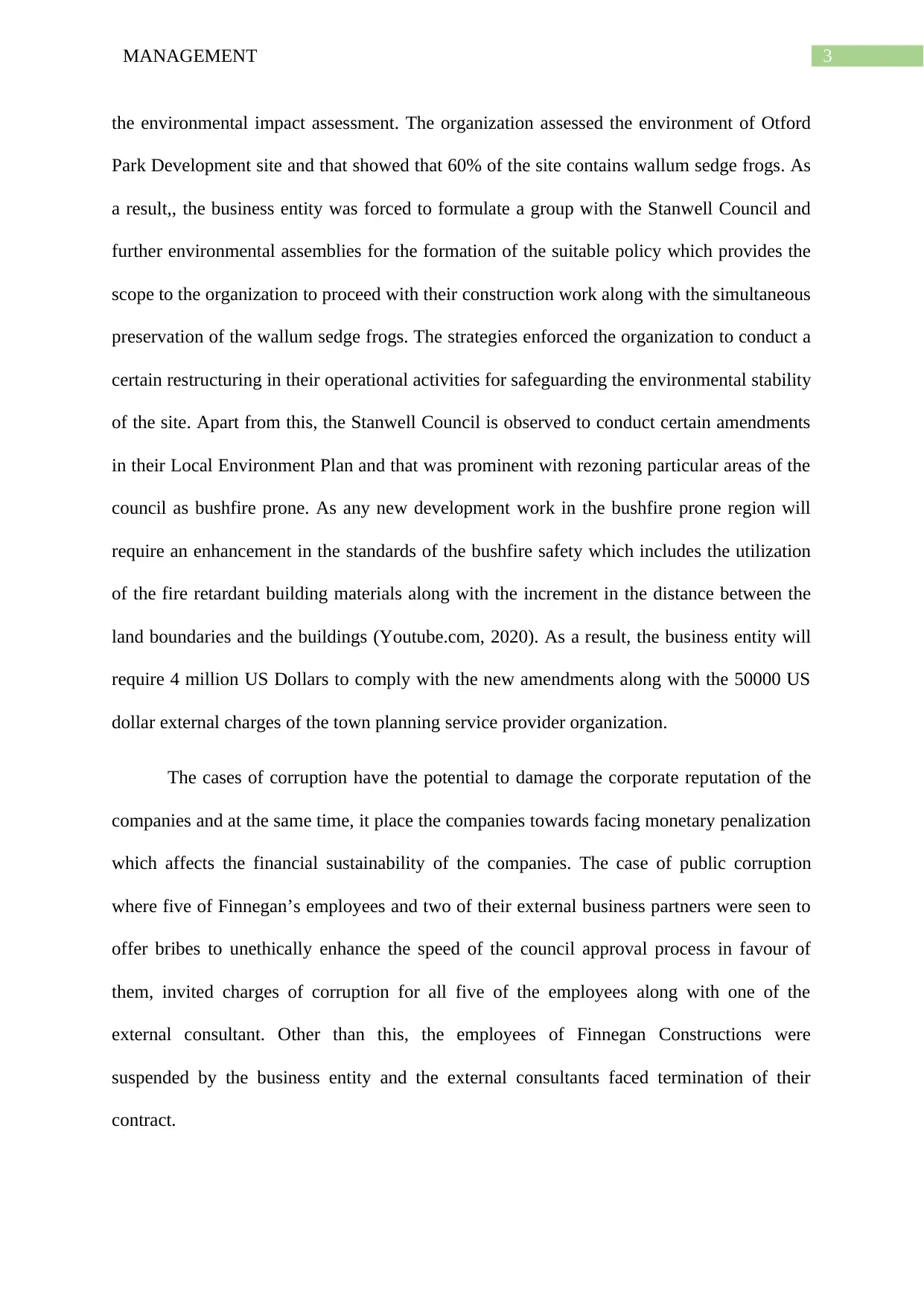
3MANAGEMENT
the environmental impact assessment. The organization assessed the environment of Otford
Park Development site and that showed that 60% of the site contains wallum sedge frogs. As
a result,, the business entity was forced to formulate a group with the Stanwell Council and
further environmental assemblies for the formation of the suitable policy which provides the
scope to the organization to proceed with their construction work along with the simultaneous
preservation of the wallum sedge frogs. The strategies enforced the organization to conduct a
certain restructuring in their operational activities for safeguarding the environmental stability
of the site. Apart from this, the Stanwell Council is observed to conduct certain amendments
in their Local Environment Plan and that was prominent with rezoning particular areas of the
council as bushfire prone. As any new development work in the bushfire prone region will
require an enhancement in the standards of the bushfire safety which includes the utilization
of the fire retardant building materials along with the increment in the distance between the
land boundaries and the buildings (Youtube.com, 2020). As a result, the business entity will
require 4 million US Dollars to comply with the new amendments along with the 50000 US
dollar external charges of the town planning service provider organization.
The cases of corruption have the potential to damage the corporate reputation of the
companies and at the same time, it place the companies towards facing monetary penalization
which affects the financial sustainability of the companies. The case of public corruption
where five of Finnegan’s employees and two of their external business partners were seen to
offer bribes to unethically enhance the speed of the council approval process in favour of
them, invited charges of corruption for all five of the employees along with one of the
external consultant. Other than this, the employees of Finnegan Constructions were
suspended by the business entity and the external consultants faced termination of their
contract.
the environmental impact assessment. The organization assessed the environment of Otford
Park Development site and that showed that 60% of the site contains wallum sedge frogs. As
a result,, the business entity was forced to formulate a group with the Stanwell Council and
further environmental assemblies for the formation of the suitable policy which provides the
scope to the organization to proceed with their construction work along with the simultaneous
preservation of the wallum sedge frogs. The strategies enforced the organization to conduct a
certain restructuring in their operational activities for safeguarding the environmental stability
of the site. Apart from this, the Stanwell Council is observed to conduct certain amendments
in their Local Environment Plan and that was prominent with rezoning particular areas of the
council as bushfire prone. As any new development work in the bushfire prone region will
require an enhancement in the standards of the bushfire safety which includes the utilization
of the fire retardant building materials along with the increment in the distance between the
land boundaries and the buildings (Youtube.com, 2020). As a result, the business entity will
require 4 million US Dollars to comply with the new amendments along with the 50000 US
dollar external charges of the town planning service provider organization.
The cases of corruption have the potential to damage the corporate reputation of the
companies and at the same time, it place the companies towards facing monetary penalization
which affects the financial sustainability of the companies. The case of public corruption
where five of Finnegan’s employees and two of their external business partners were seen to
offer bribes to unethically enhance the speed of the council approval process in favour of
them, invited charges of corruption for all five of the employees along with one of the
external consultant. Other than this, the employees of Finnegan Constructions were
suspended by the business entity and the external consultants faced termination of their
contract.
Paraphrase This Document
Need a fresh take? Get an instant paraphrase of this document with our AI Paraphraser
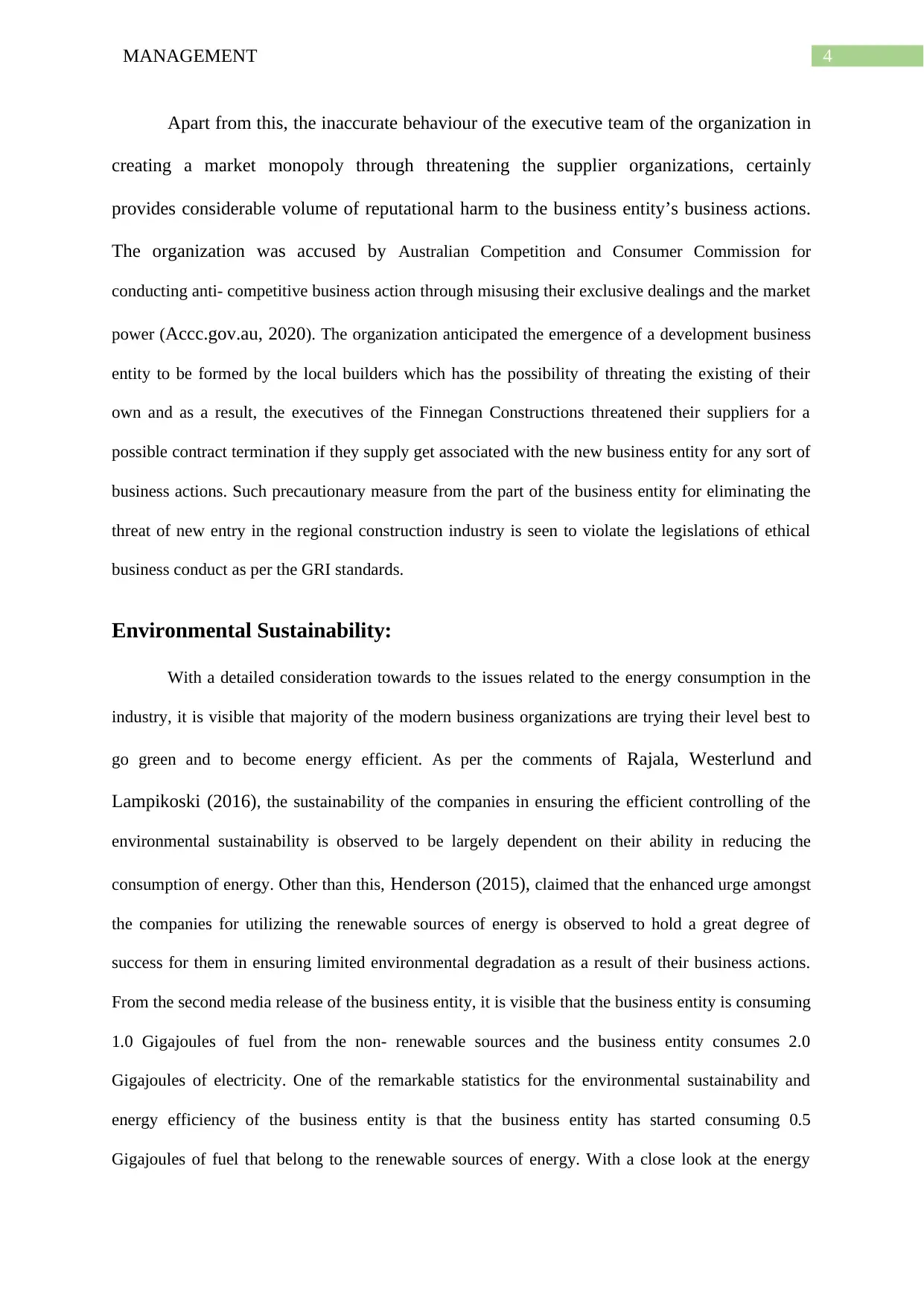
4MANAGEMENT
Apart from this, the inaccurate behaviour of the executive team of the organization in
creating a market monopoly through threatening the supplier organizations, certainly
provides considerable volume of reputational harm to the business entity’s business actions.
The organization was accused by Australian Competition and Consumer Commission for
conducting anti- competitive business action through misusing their exclusive dealings and the market
power (Accc.gov.au, 2020). The organization anticipated the emergence of a development business
entity to be formed by the local builders which has the possibility of threating the existing of their
own and as a result, the executives of the Finnegan Constructions threatened their suppliers for a
possible contract termination if they supply get associated with the new business entity for any sort of
business actions. Such precautionary measure from the part of the business entity for eliminating the
threat of new entry in the regional construction industry is seen to violate the legislations of ethical
business conduct as per the GRI standards.
Environmental Sustainability:
With a detailed consideration towards to the issues related to the energy consumption in the
industry, it is visible that majority of the modern business organizations are trying their level best to
go green and to become energy efficient. As per the comments of Rajala, Westerlund and
Lampikoski (2016), the sustainability of the companies in ensuring the efficient controlling of the
environmental sustainability is observed to be largely dependent on their ability in reducing the
consumption of energy. Other than this, Henderson (2015), claimed that the enhanced urge amongst
the companies for utilizing the renewable sources of energy is observed to hold a great degree of
success for them in ensuring limited environmental degradation as a result of their business actions.
From the second media release of the business entity, it is visible that the business entity is consuming
1.0 Gigajoules of fuel from the non- renewable sources and the business entity consumes 2.0
Gigajoules of electricity. One of the remarkable statistics for the environmental sustainability and
energy efficiency of the business entity is that the business entity has started consuming 0.5
Gigajoules of fuel that belong to the renewable sources of energy. With a close look at the energy
Apart from this, the inaccurate behaviour of the executive team of the organization in
creating a market monopoly through threatening the supplier organizations, certainly
provides considerable volume of reputational harm to the business entity’s business actions.
The organization was accused by Australian Competition and Consumer Commission for
conducting anti- competitive business action through misusing their exclusive dealings and the market
power (Accc.gov.au, 2020). The organization anticipated the emergence of a development business
entity to be formed by the local builders which has the possibility of threating the existing of their
own and as a result, the executives of the Finnegan Constructions threatened their suppliers for a
possible contract termination if they supply get associated with the new business entity for any sort of
business actions. Such precautionary measure from the part of the business entity for eliminating the
threat of new entry in the regional construction industry is seen to violate the legislations of ethical
business conduct as per the GRI standards.
Environmental Sustainability:
With a detailed consideration towards to the issues related to the energy consumption in the
industry, it is visible that majority of the modern business organizations are trying their level best to
go green and to become energy efficient. As per the comments of Rajala, Westerlund and
Lampikoski (2016), the sustainability of the companies in ensuring the efficient controlling of the
environmental sustainability is observed to be largely dependent on their ability in reducing the
consumption of energy. Other than this, Henderson (2015), claimed that the enhanced urge amongst
the companies for utilizing the renewable sources of energy is observed to hold a great degree of
success for them in ensuring limited environmental degradation as a result of their business actions.
From the second media release of the business entity, it is visible that the business entity is consuming
1.0 Gigajoules of fuel from the non- renewable sources and the business entity consumes 2.0
Gigajoules of electricity. One of the remarkable statistics for the environmental sustainability and
energy efficiency of the business entity is that the business entity has started consuming 0.5
Gigajoules of fuel that belong to the renewable sources of energy. With a close look at the energy
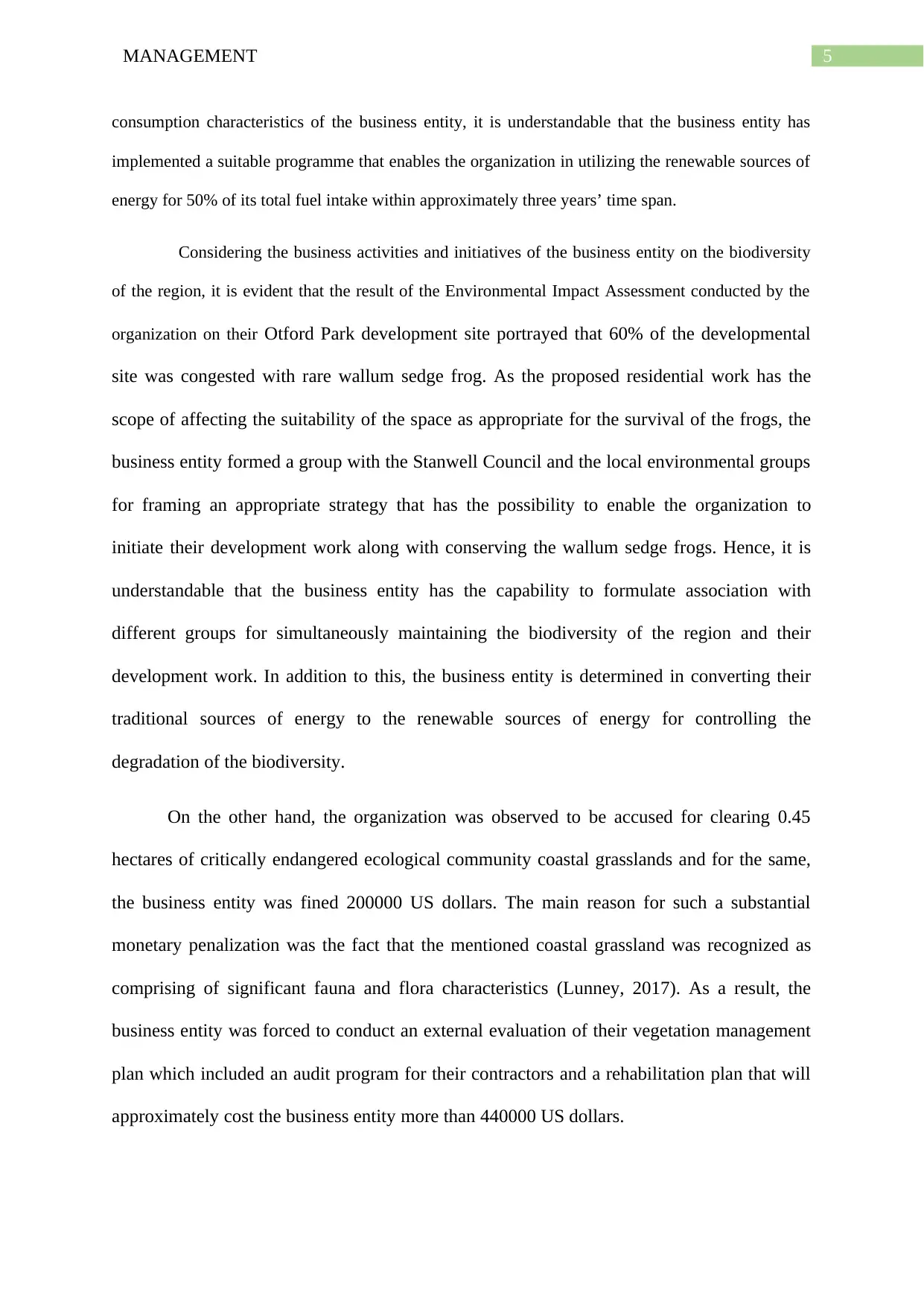
5MANAGEMENT
consumption characteristics of the business entity, it is understandable that the business entity has
implemented a suitable programme that enables the organization in utilizing the renewable sources of
energy for 50% of its total fuel intake within approximately three years’ time span.
Considering the business activities and initiatives of the business entity on the biodiversity
of the region, it is evident that the result of the Environmental Impact Assessment conducted by the
organization on their Otford Park development site portrayed that 60% of the developmental
site was congested with rare wallum sedge frog. As the proposed residential work has the
scope of affecting the suitability of the space as appropriate for the survival of the frogs, the
business entity formed a group with the Stanwell Council and the local environmental groups
for framing an appropriate strategy that has the possibility to enable the organization to
initiate their development work along with conserving the wallum sedge frogs. Hence, it is
understandable that the business entity has the capability to formulate association with
different groups for simultaneously maintaining the biodiversity of the region and their
development work. In addition to this, the business entity is determined in converting their
traditional sources of energy to the renewable sources of energy for controlling the
degradation of the biodiversity.
On the other hand, the organization was observed to be accused for clearing 0.45
hectares of critically endangered ecological community coastal grasslands and for the same,
the business entity was fined 200000 US dollars. The main reason for such a substantial
monetary penalization was the fact that the mentioned coastal grassland was recognized as
comprising of significant fauna and flora characteristics (Lunney, 2017). As a result, the
business entity was forced to conduct an external evaluation of their vegetation management
plan which included an audit program for their contractors and a rehabilitation plan that will
approximately cost the business entity more than 440000 US dollars.
consumption characteristics of the business entity, it is understandable that the business entity has
implemented a suitable programme that enables the organization in utilizing the renewable sources of
energy for 50% of its total fuel intake within approximately three years’ time span.
Considering the business activities and initiatives of the business entity on the biodiversity
of the region, it is evident that the result of the Environmental Impact Assessment conducted by the
organization on their Otford Park development site portrayed that 60% of the developmental
site was congested with rare wallum sedge frog. As the proposed residential work has the
scope of affecting the suitability of the space as appropriate for the survival of the frogs, the
business entity formed a group with the Stanwell Council and the local environmental groups
for framing an appropriate strategy that has the possibility to enable the organization to
initiate their development work along with conserving the wallum sedge frogs. Hence, it is
understandable that the business entity has the capability to formulate association with
different groups for simultaneously maintaining the biodiversity of the region and their
development work. In addition to this, the business entity is determined in converting their
traditional sources of energy to the renewable sources of energy for controlling the
degradation of the biodiversity.
On the other hand, the organization was observed to be accused for clearing 0.45
hectares of critically endangered ecological community coastal grasslands and for the same,
the business entity was fined 200000 US dollars. The main reason for such a substantial
monetary penalization was the fact that the mentioned coastal grassland was recognized as
comprising of significant fauna and flora characteristics (Lunney, 2017). As a result, the
business entity was forced to conduct an external evaluation of their vegetation management
plan which included an audit program for their contractors and a rehabilitation plan that will
approximately cost the business entity more than 440000 US dollars.
⊘ This is a preview!⊘
Do you want full access?
Subscribe today to unlock all pages.

Trusted by 1+ million students worldwide
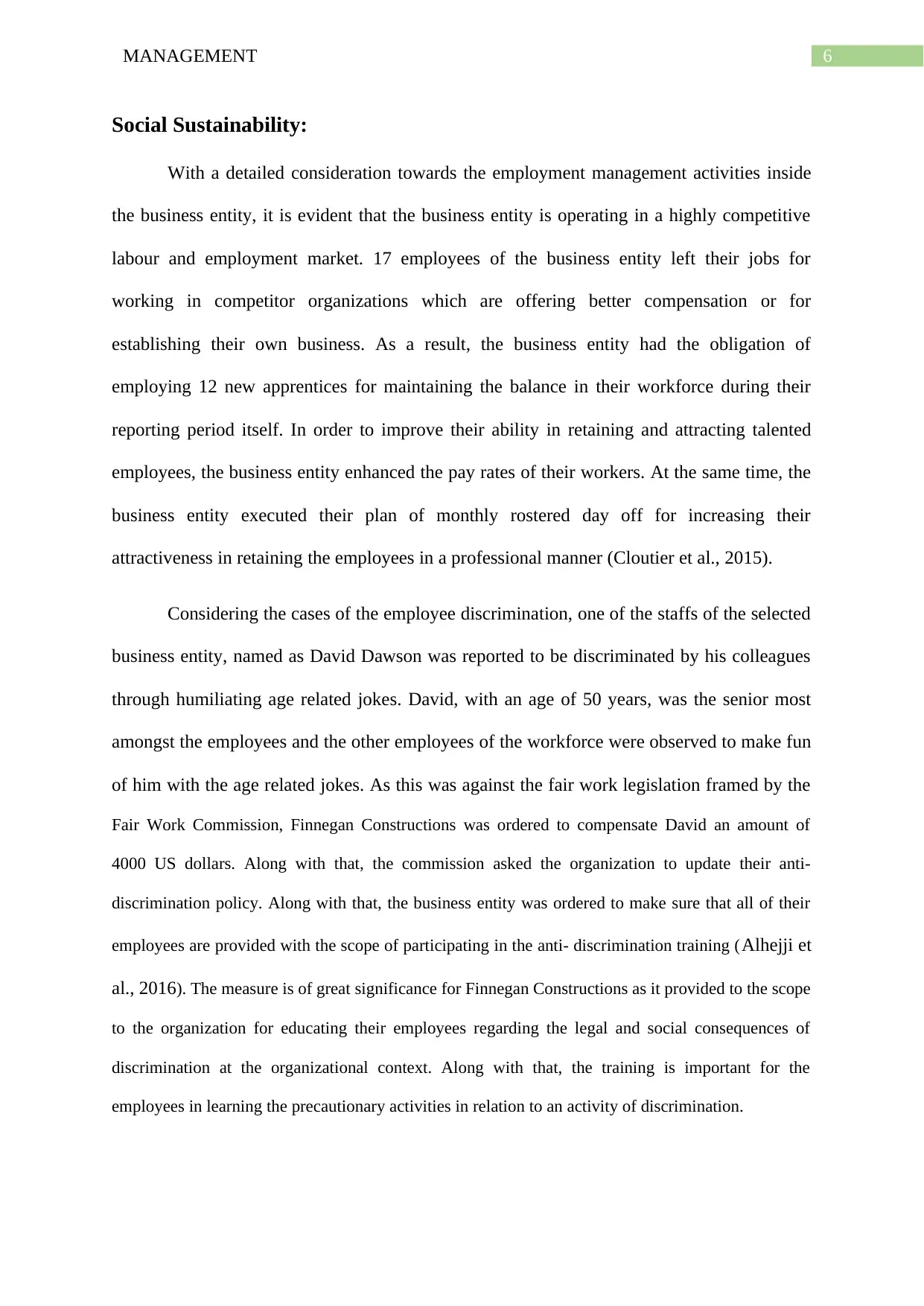
6MANAGEMENT
Social Sustainability:
With a detailed consideration towards the employment management activities inside
the business entity, it is evident that the business entity is operating in a highly competitive
labour and employment market. 17 employees of the business entity left their jobs for
working in competitor organizations which are offering better compensation or for
establishing their own business. As a result, the business entity had the obligation of
employing 12 new apprentices for maintaining the balance in their workforce during their
reporting period itself. In order to improve their ability in retaining and attracting talented
employees, the business entity enhanced the pay rates of their workers. At the same time, the
business entity executed their plan of monthly rostered day off for increasing their
attractiveness in retaining the employees in a professional manner (Cloutier et al., 2015).
Considering the cases of the employee discrimination, one of the staffs of the selected
business entity, named as David Dawson was reported to be discriminated by his colleagues
through humiliating age related jokes. David, with an age of 50 years, was the senior most
amongst the employees and the other employees of the workforce were observed to make fun
of him with the age related jokes. As this was against the fair work legislation framed by the
Fair Work Commission, Finnegan Constructions was ordered to compensate David an amount of
4000 US dollars. Along with that, the commission asked the organization to update their anti-
discrimination policy. Along with that, the business entity was ordered to make sure that all of their
employees are provided with the scope of participating in the anti- discrimination training (Alhejji et
al., 2016). The measure is of great significance for Finnegan Constructions as it provided to the scope
to the organization for educating their employees regarding the legal and social consequences of
discrimination at the organizational context. Along with that, the training is important for the
employees in learning the precautionary activities in relation to an activity of discrimination.
Social Sustainability:
With a detailed consideration towards the employment management activities inside
the business entity, it is evident that the business entity is operating in a highly competitive
labour and employment market. 17 employees of the business entity left their jobs for
working in competitor organizations which are offering better compensation or for
establishing their own business. As a result, the business entity had the obligation of
employing 12 new apprentices for maintaining the balance in their workforce during their
reporting period itself. In order to improve their ability in retaining and attracting talented
employees, the business entity enhanced the pay rates of their workers. At the same time, the
business entity executed their plan of monthly rostered day off for increasing their
attractiveness in retaining the employees in a professional manner (Cloutier et al., 2015).
Considering the cases of the employee discrimination, one of the staffs of the selected
business entity, named as David Dawson was reported to be discriminated by his colleagues
through humiliating age related jokes. David, with an age of 50 years, was the senior most
amongst the employees and the other employees of the workforce were observed to make fun
of him with the age related jokes. As this was against the fair work legislation framed by the
Fair Work Commission, Finnegan Constructions was ordered to compensate David an amount of
4000 US dollars. Along with that, the commission asked the organization to update their anti-
discrimination policy. Along with that, the business entity was ordered to make sure that all of their
employees are provided with the scope of participating in the anti- discrimination training (Alhejji et
al., 2016). The measure is of great significance for Finnegan Constructions as it provided to the scope
to the organization for educating their employees regarding the legal and social consequences of
discrimination at the organizational context. Along with that, the training is important for the
employees in learning the precautionary activities in relation to an activity of discrimination.
Paraphrase This Document
Need a fresh take? Get an instant paraphrase of this document with our AI Paraphraser
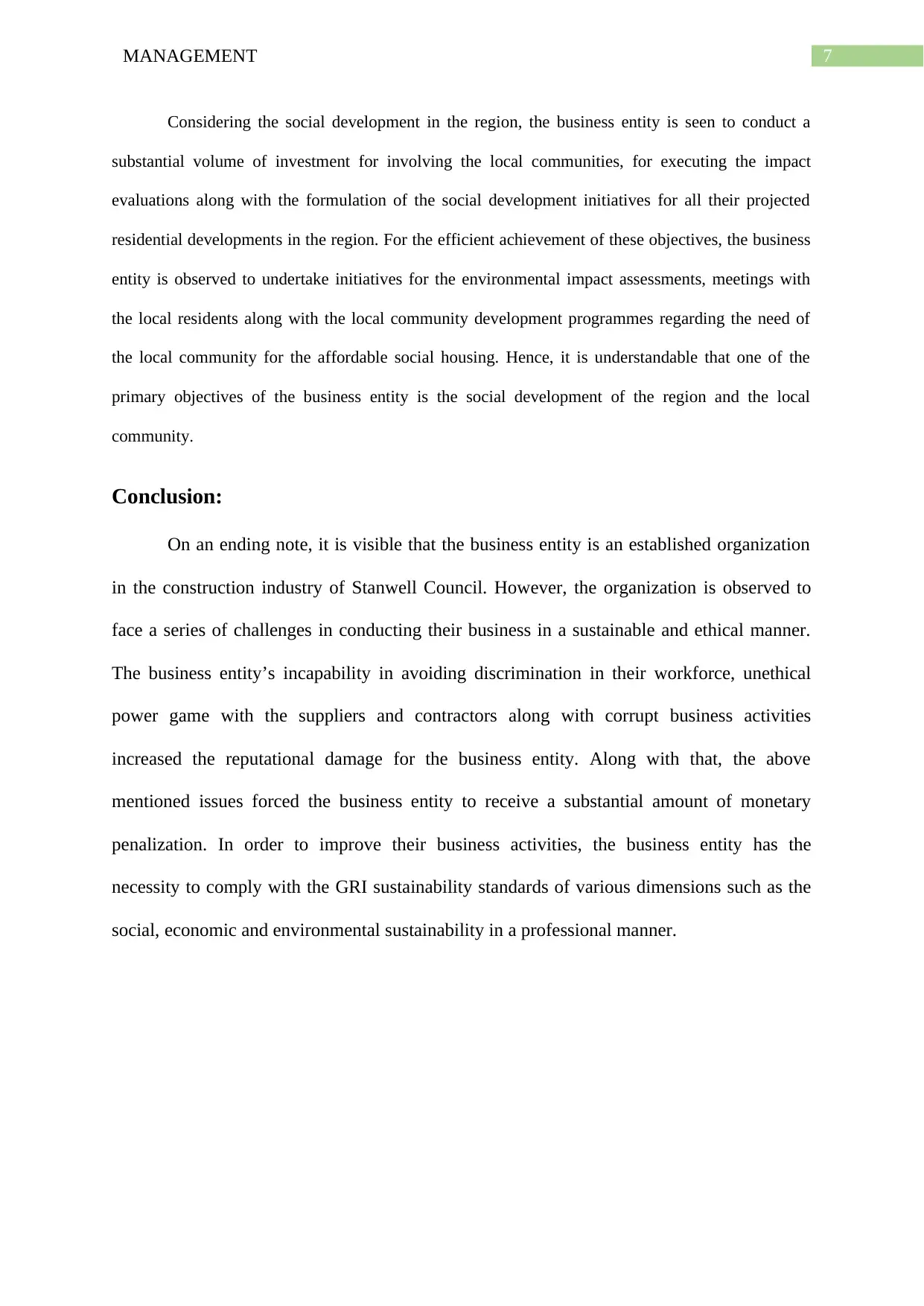
7MANAGEMENT
Considering the social development in the region, the business entity is seen to conduct a
substantial volume of investment for involving the local communities, for executing the impact
evaluations along with the formulation of the social development initiatives for all their projected
residential developments in the region. For the efficient achievement of these objectives, the business
entity is observed to undertake initiatives for the environmental impact assessments, meetings with
the local residents along with the local community development programmes regarding the need of
the local community for the affordable social housing. Hence, it is understandable that one of the
primary objectives of the business entity is the social development of the region and the local
community.
Conclusion:
On an ending note, it is visible that the business entity is an established organization
in the construction industry of Stanwell Council. However, the organization is observed to
face a series of challenges in conducting their business in a sustainable and ethical manner.
The business entity’s incapability in avoiding discrimination in their workforce, unethical
power game with the suppliers and contractors along with corrupt business activities
increased the reputational damage for the business entity. Along with that, the above
mentioned issues forced the business entity to receive a substantial amount of monetary
penalization. In order to improve their business activities, the business entity has the
necessity to comply with the GRI sustainability standards of various dimensions such as the
social, economic and environmental sustainability in a professional manner.
Considering the social development in the region, the business entity is seen to conduct a
substantial volume of investment for involving the local communities, for executing the impact
evaluations along with the formulation of the social development initiatives for all their projected
residential developments in the region. For the efficient achievement of these objectives, the business
entity is observed to undertake initiatives for the environmental impact assessments, meetings with
the local residents along with the local community development programmes regarding the need of
the local community for the affordable social housing. Hence, it is understandable that one of the
primary objectives of the business entity is the social development of the region and the local
community.
Conclusion:
On an ending note, it is visible that the business entity is an established organization
in the construction industry of Stanwell Council. However, the organization is observed to
face a series of challenges in conducting their business in a sustainable and ethical manner.
The business entity’s incapability in avoiding discrimination in their workforce, unethical
power game with the suppliers and contractors along with corrupt business activities
increased the reputational damage for the business entity. Along with that, the above
mentioned issues forced the business entity to receive a substantial amount of monetary
penalization. In order to improve their business activities, the business entity has the
necessity to comply with the GRI sustainability standards of various dimensions such as the
social, economic and environmental sustainability in a professional manner.
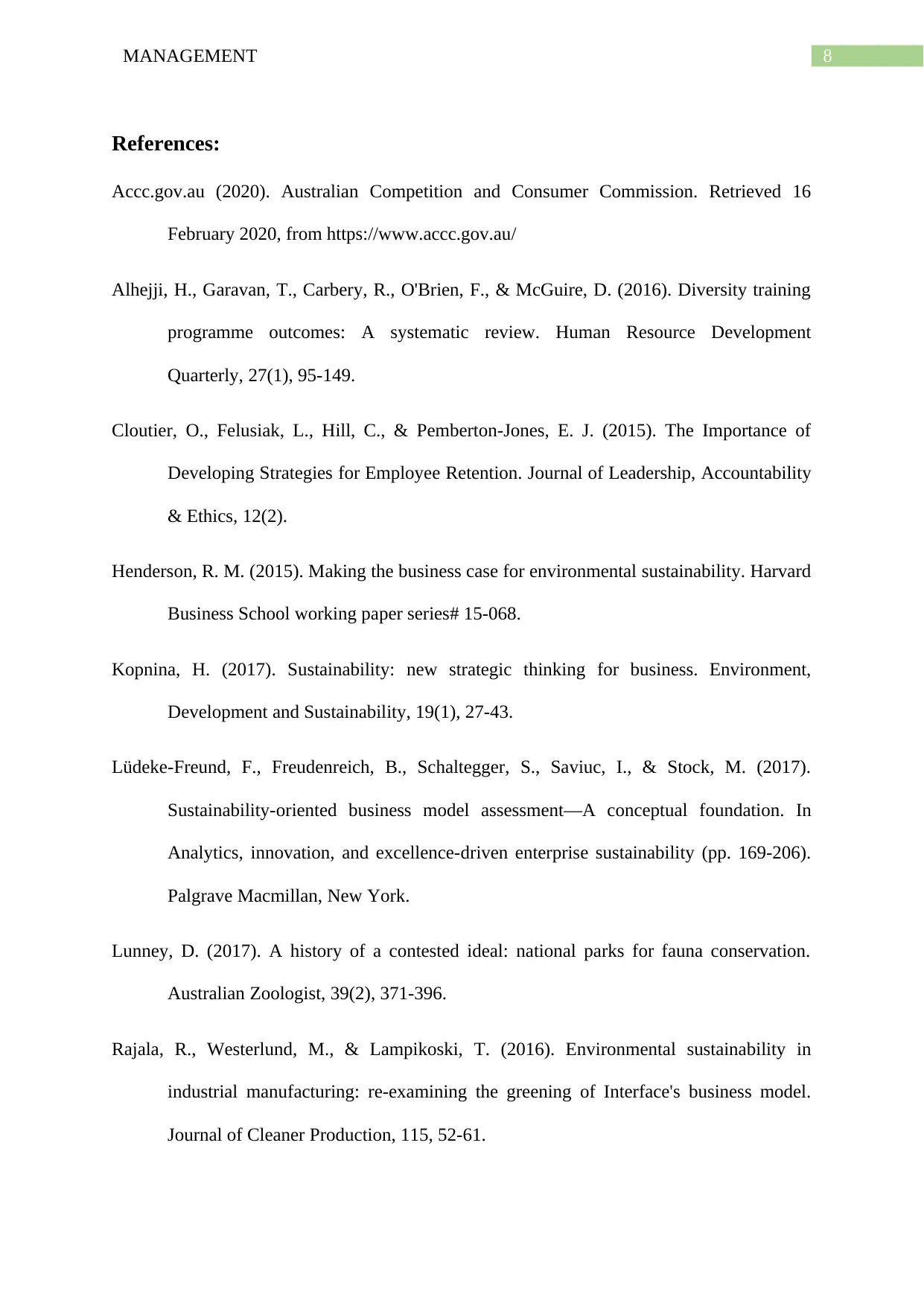
8MANAGEMENT
References:
Accc.gov.au (2020). Australian Competition and Consumer Commission. Retrieved 16
February 2020, from https://www.accc.gov.au/
Alhejji, H., Garavan, T., Carbery, R., O'Brien, F., & McGuire, D. (2016). Diversity training
programme outcomes: A systematic review. Human Resource Development
Quarterly, 27(1), 95-149.
Cloutier, O., Felusiak, L., Hill, C., & Pemberton-Jones, E. J. (2015). The Importance of
Developing Strategies for Employee Retention. Journal of Leadership, Accountability
& Ethics, 12(2).
Henderson, R. M. (2015). Making the business case for environmental sustainability. Harvard
Business School working paper series# 15-068.
Kopnina, H. (2017). Sustainability: new strategic thinking for business. Environment,
Development and Sustainability, 19(1), 27-43.
Lüdeke-Freund, F., Freudenreich, B., Schaltegger, S., Saviuc, I., & Stock, M. (2017).
Sustainability-oriented business model assessment—A conceptual foundation. In
Analytics, innovation, and excellence-driven enterprise sustainability (pp. 169-206).
Palgrave Macmillan, New York.
Lunney, D. (2017). A history of a contested ideal: national parks for fauna conservation.
Australian Zoologist, 39(2), 371-396.
Rajala, R., Westerlund, M., & Lampikoski, T. (2016). Environmental sustainability in
industrial manufacturing: re-examining the greening of Interface's business model.
Journal of Cleaner Production, 115, 52-61.
References:
Accc.gov.au (2020). Australian Competition and Consumer Commission. Retrieved 16
February 2020, from https://www.accc.gov.au/
Alhejji, H., Garavan, T., Carbery, R., O'Brien, F., & McGuire, D. (2016). Diversity training
programme outcomes: A systematic review. Human Resource Development
Quarterly, 27(1), 95-149.
Cloutier, O., Felusiak, L., Hill, C., & Pemberton-Jones, E. J. (2015). The Importance of
Developing Strategies for Employee Retention. Journal of Leadership, Accountability
& Ethics, 12(2).
Henderson, R. M. (2015). Making the business case for environmental sustainability. Harvard
Business School working paper series# 15-068.
Kopnina, H. (2017). Sustainability: new strategic thinking for business. Environment,
Development and Sustainability, 19(1), 27-43.
Lüdeke-Freund, F., Freudenreich, B., Schaltegger, S., Saviuc, I., & Stock, M. (2017).
Sustainability-oriented business model assessment—A conceptual foundation. In
Analytics, innovation, and excellence-driven enterprise sustainability (pp. 169-206).
Palgrave Macmillan, New York.
Lunney, D. (2017). A history of a contested ideal: national parks for fauna conservation.
Australian Zoologist, 39(2), 371-396.
Rajala, R., Westerlund, M., & Lampikoski, T. (2016). Environmental sustainability in
industrial manufacturing: re-examining the greening of Interface's business model.
Journal of Cleaner Production, 115, 52-61.
⊘ This is a preview!⊘
Do you want full access?
Subscribe today to unlock all pages.

Trusted by 1+ million students worldwide
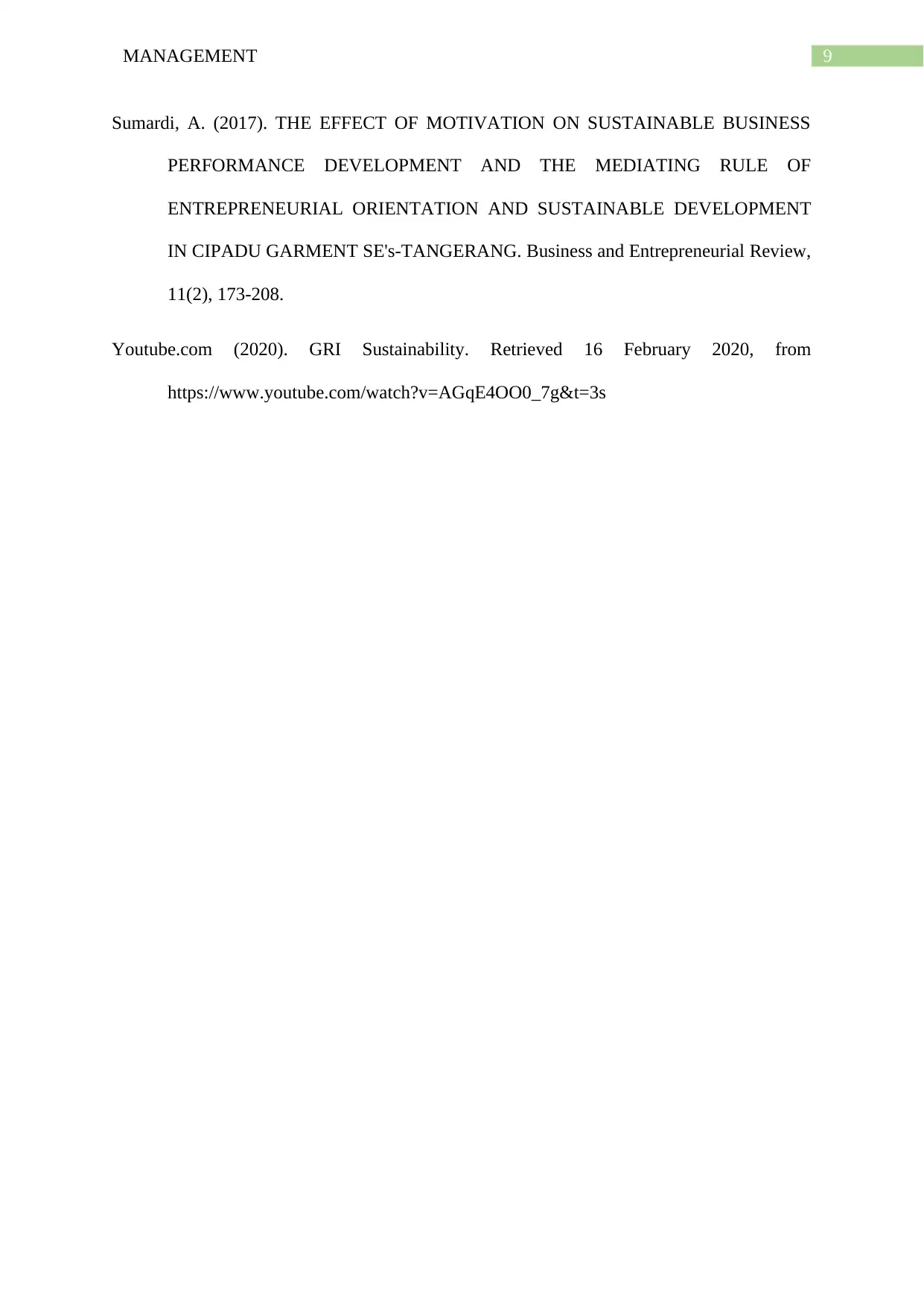
9MANAGEMENT
Sumardi, A. (2017). THE EFFECT OF MOTIVATION ON SUSTAINABLE BUSINESS
PERFORMANCE DEVELOPMENT AND THE MEDIATING RULE OF
ENTREPRENEURIAL ORIENTATION AND SUSTAINABLE DEVELOPMENT
IN CIPADU GARMENT SE's-TANGERANG. Business and Entrepreneurial Review,
11(2), 173-208.
Youtube.com (2020). GRI Sustainability. Retrieved 16 February 2020, from
https://www.youtube.com/watch?v=AGqE4OO0_7g&t=3s
Sumardi, A. (2017). THE EFFECT OF MOTIVATION ON SUSTAINABLE BUSINESS
PERFORMANCE DEVELOPMENT AND THE MEDIATING RULE OF
ENTREPRENEURIAL ORIENTATION AND SUSTAINABLE DEVELOPMENT
IN CIPADU GARMENT SE's-TANGERANG. Business and Entrepreneurial Review,
11(2), 173-208.
Youtube.com (2020). GRI Sustainability. Retrieved 16 February 2020, from
https://www.youtube.com/watch?v=AGqE4OO0_7g&t=3s
1 out of 10
Related Documents
Your All-in-One AI-Powered Toolkit for Academic Success.
+13062052269
info@desklib.com
Available 24*7 on WhatsApp / Email
![[object Object]](/_next/static/media/star-bottom.7253800d.svg)
Unlock your academic potential
Copyright © 2020–2025 A2Z Services. All Rights Reserved. Developed and managed by ZUCOL.



